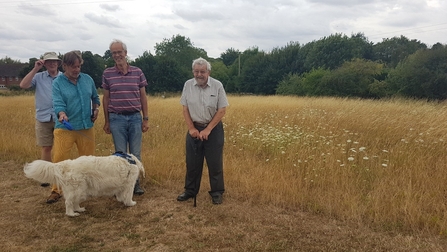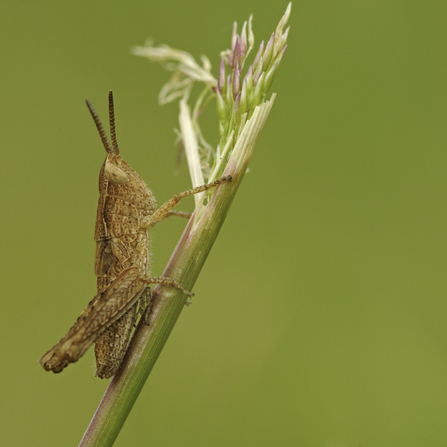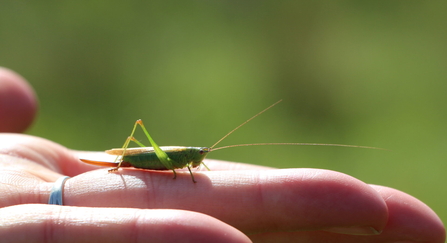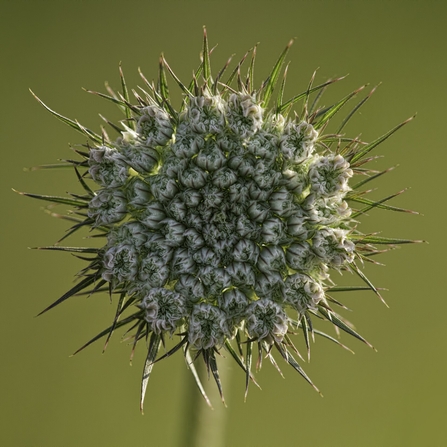Situated within the heart of the west Suffolk rural village lies a large allotment field. We hear many stories of long waiting lists for allotments but given the size of the population in comparison to the size of the field, over six acres, it is not surprising that much of the land has been underutilised as allotment for some time. Back in 2020, a group of interested people from the village, formed the Hundon Allotment Tenants Association (HATA) and took over management, initially of the allotments, and creation of a community orchard. To build on the group’s ideas they soon sought to bring expert advice in from various organisations, including Suffolk Wildlife Trust.
Hundon Village Community Land
Common blue butterfly - Steve Aylward

Hundon naturalists - Cathy Smith
One of the initial aims of the group was to gather species records which led to the establishment of Hundon naturalists group. The group is fortunate to have as a guiding light Michael Chinery, naturalist and a leading writer on insects. His Collins Field Guide to ‘Insects’ sadly now out of print, is one of the best available, and still remains my mainstay for ‘bug’ hunts. His publications include others aimed at helping young people to explore nature and more specialist works such as editing the British Plant Gall Society’s journal Cecidology. Walking through the meadow his quick eyes recognise a common blue butterfly shortly followed by a meadow grasshopper. It is impossible to pass by without his quiet enthusiasm drawing us into the miniature world at our feet.

Field grasshopper (Chorthippus brunneus) - Dawn Monrose
Already the insect life is responding to the change from frequent mowing to meadow management. Plant ecologist Ken Thompson suggests that up to 10 more species of bugs and 50 times more individual bugs live in long grass than short grass. Further studies have also shown that invertebrate communities decline with increased mowing intensity, so whether looking after a garden lawn or, as in this case, a meadow, leaving the grass to grow is a simple way to help reverse insect declines. These findings are born out here in Hundon, with 65 species now recorded, including the long-winged conehead (Conocephalus fuscus) a once rare bush-cricket that has been spreading rapidly across southern England in recent years.

Long-winged conehead - Lianne de Mello
This is a meadow in the making. Yellow rattle, which is semi-parasitic on grass and sometimes referred to as the ‘meadow maker’ as it suppresses grass growth, has been sown and successfully established. The group demonstrate how the yellow rattle seed pods make a satisfyingly rattle now the seeds are ripe. Wild carrot is thriving, a magnet for pollinating insects and a crowd pleaser, its delicate white umbels turn to equally attractive birds’ nest-like seed heads. More than 50 species of flowering herbs have been recorded on site so far.

Wild Carrot- Guy Edwardes/2020VISION
The group’s positive approach has encouraged an annual meadow cutting and raking work party, their enthusiasm making light of the hard work. For the moment the meadow has been cut in September, but they plan to create a mosaic of cutting regimes within the meadow to favour different species. Just two years in, and this community group has transformed a dull mown field into a wildlife refuge. I can’t wait to see what it will look like in another couple of years.
Planning to create or restore your own meadow? Join our Planning a Meadow Course on Wednesday 14 September to learn more.
See all courses:
Courses | Suffolk Wildlife Trust
See also;
Meadows and grassland | Suffolk Wildlife Trust
Action for insects | Suffolk Wildlife Trust
References
Watson CJ, Carignan-Guillemette L, Turcotte C, Maire V, Proulx R. Ecological and economic benefits of low-intensity urban lawn management. J Appl Ecol. 2020;57:436–446. https://doi.org/10.1111/1365-2664.13542
